1. Undernourishment
Insufficient food supply is often a major cause of stunted, slowed, or delayed growth in most young and small bearded dragons. Most species of baby and juvenile beardies grow at a frantic rate.
Equally, they require and consume vast supplies of pet beardie food to maintain their fast-paced growth into maturity.
Naturally, a bearded dragon won’t grow properly if their diet lacks sufficient food. Besides being small, a malnourished beardie is often bony, emaciated aggressive, and is habitually inactive.
Thus, it’s crucial that you feed your beardie pets with enough food. Further, ensure you feed them enough times each day to support their aggressive growth.
Typically, baby and juvenile bearded dragons should eat frequently (three to five times daily) whereas adult beardies should feed approximately five to six days each week.
However, these feeding frequencies depend on the species and age of your beardie, so they can vary slightly.
Besides stunted growth, malnourishment in bearded dragons can cause other complications in appetite, organ development, and the general attitude of your pet beardies.
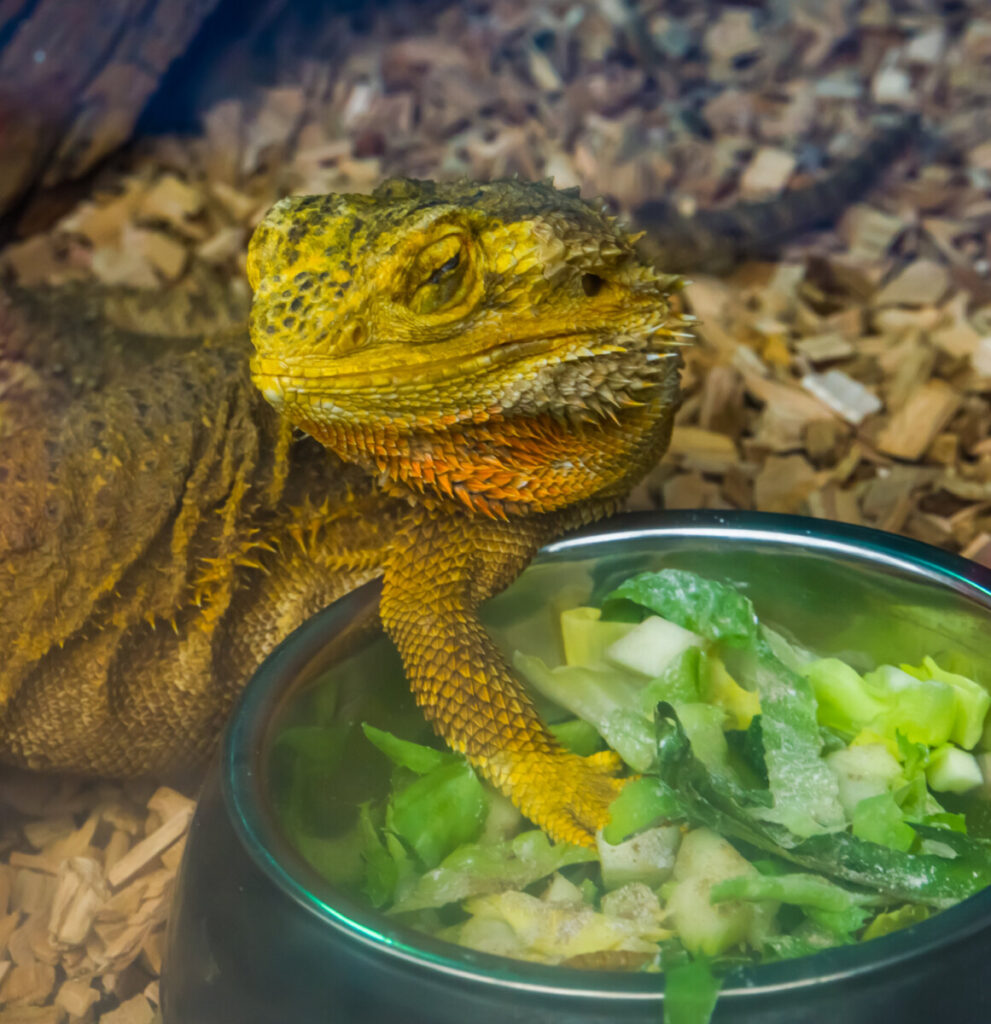
2. Imbalanced Diet
Even as you feed your bearded dragon with sufficient food in the right frequency, an imbalance in vital nutrients can also lead to the pets’ stunted growth.
Young beardies require more proteins to foster growth while their older counterparts need an abundance of greens with calcium and other nutrients in their diet.
Moreover, the lizards require varying balances of proteins and greens as they get older to help them grow healthily to their full size.
Naturally, caged bearded dragons enjoy much less sunbathing in their artificial habitat than those in their natural habitats.
Thus, captive beardies require sufficient artificial UVB light setup to supplement the low-quality natural UV light in their terrarium.
Remember UV light fosters natural vitamin D that’s crucial for proper growth and development of bones.
And that’s not all. Captive bearded dragons need constant high-quality calcium supplements for normal bone and muscle growth and development.
Without these supplements, your beardies are at risk of illnesses such as metabolic bone disease (MDB) besides struggling to grow properly.
Possibly the best way to resolve stunted growth in bearded dragons due to an imbalanced diet is by feeding your pets with a balanced-out diet all the time. Here’s an easy way to achieve this:
- Increase the quantity and quality of calcium-rich proteins, insects (such as Dubia roaches), and greens in your beardie’s diet
- Sprinkle dietary supplements rich in calcium and other nutrients on your bearded dragon’s food
- Gut-load insects such as crickets with calcium a day before feeding them to the captive beardie to boost their calcium levels
- Feed your baby and juvenile beardies with 70% insect proteins and 30% greens. Gradually revise the diet toward 30% insect protein and 70% greens as the lizards grow into adults.
To guarantee your pet beardies a healthy and fast growth, stick to a healthy diet and feeding patterns.
Feed the pets a balanced diet even when their growth, health, and attitude are at their best to keep them calm, healthy, happy, and active.
3. Improper UVB Light Setup
Insufficient UV light is another common reason for retarded growth in bearded dragons. These lizards originated from the Australian desert, and they require the vitamin D in the sun’s UV rays to absorb valuable nutrients such as calcium from their diet.
Likewise, captive beardies need sufficient UVB radiation from special bulbs for optimal nutrition and growth.
In the absence of sufficient UVB lighting, your beardie will most likely grow sluggishly or stop growing even with the most nutrient-rich diet.
An inadequate supply of vitamin D due to poor UVB lighting makes most of the calcium in the food to go to waste as the beardie can’t assimilate it into their body.
Consequently, the rate, size, and quality of your bearded dragon’s growth and overall health are likely to slump.
A beardie that doesn’t grow properly due to inappropriate UVB setup is highly likely to experience multiple health problems such as muscle complications, underdeveloped and weak bones, and metabolic bone disease (MBD) among other complex illnesses.
Here’s the good news: You can strike UVB-related stunted growth from your beardie’s life by setting up specialized and dedicated UVB light in their tank.
Typically, a bearded dragon should enjoy at least 12 hours of the UVB light each day to help them absorb and utilize nutrients from their food for healthy growth.
Further, you can get a timer switch to control when the UVB light goes on and off in the beardie tank.
Ensure the light stays on for at least 12 hours during the day and then turn it off at night to assure your lizard all-round healthy growth.
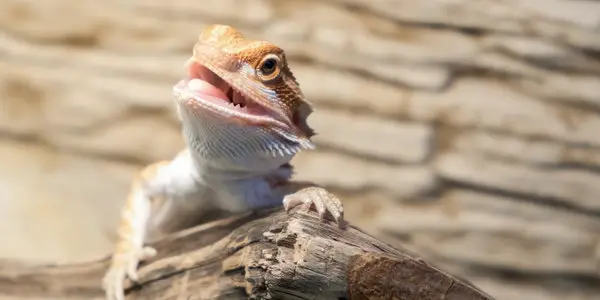
4. Presence of Parasites
The presence of parasites in your bearded dragon’s body can lead to a massive decline in the pet’s growth and a consequent severe impact on their health.
Although they’re often overlooked as they’re imperceptible to the naked eye, parasites such as pinworms are quite common in beardies.
Most bearded dragon parasites live in the beardie’s digestive tract where they take up most of the pet’s nutrition from ingested food.
As a result, a parasite-infested beardie only accesses part of the nutrition from the food they eat, thus are more likely to be frail, skinny, and stressed out.
It gets more interesting: The more and the longer your beardie harbors parasites, the worse it gets. At best, the parasites cause minor discomfort and brooding.
However, unresolved presence of parasites is bound to drive your beardie into malnourishment and cause loose stool (diarrhea) and acute weight loss in the long run.
Probably the best cause of action is to seek immediate reptile vet intervention if you suspect or establish that your beardie has been attacked by parasites.
The vet can perform a fecal test to determine a parasite infestation. Besides, the vet is best placed to offer you the most efficient means to liberate your pet from those blood-and-life-suckers.
5. Unsuitable Tank Temperatures
Lack of favorable tank temperatures is a recipe for delaying or hampering growth in caged bearded dragons.
The hot Australian desert is the native natural home to bearded dragons for a number of reasons. The lizards love the high temperatures as the heat helps them to digest food and accumulate energy.
Similarly captive beardies require optimal temperatures in the basking section of their tank for effective food digestion and nutrient assimilation into their system.
If the temperature falls below the optimal levels, your lizard may find it nearly impossible to digest their food. Worse yet, the beardie’s appetite could plummet, and this can make it hard to grow to their standard size.
Beyond impeding food digestion and nutrient absorption, unfavorable tank temperatures lowers the frequency a beardie eats per day, the amount of food they consume, and the nutrients their body uptakes.
Ultimately, unsuitable tank temperatures slow down or completely halt a beardie’s normal growth trajectory.
Luckily, maintaining optimal temperature ranges in all tank sections is enough to drive out temperature-related retarded growth in beardies.
Usually, you should keep the temperatures in the basking area of baby and juvenile bearded dragons at around 110° Fahrenheit (43° C).
In the same breath, maintain the temperatures of adult beardies’ basking spots at 105° Fahrenheit (41° C) to enable them to feed, digest food, absorb nutrients, and thrive in growth and health.
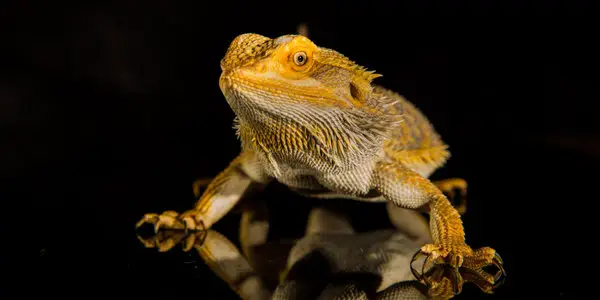
6. Inadequate Tank Space
We can agree that bearded dragons are exceptionally active lizards and playful pets. They love exploring and sight-seeing, so they need sufficient cage space to move around and bloom to their maximum size.
In the same way an aquatic pets can’t overgrow their aquarium, a bearded dragon grows in sync with its tank size- their growth slows down or tops entirely if the tank is too small.
Although bearded dragons vary in size, it’s a rule of thumb that you need at least a 40-gallon tank for the smallest baby bearded dragon. You’ll need 75, 100-gallon, or larger tanks for bigger juvenile and adult beardies.
Here’s an interesting fact: it’s not recommended to house baby beardies in overly large tanks. Rather, put them in a conveniently-sized cage.
Thereafter, you can transfer them to a larger tank befitting their size as they grow into adult beardies. This process helps the lizards to gradually adjust to their artificial habitat as they grow.
7. Sharing their Enclosure
Keeping more than one bearded dragon in the same cage or introducing another pet into a bearded dragon tank can slow or hinder the beardie’s growth. Bearded dragons are solitary and extremely territorial reptiles that love their private space.
Placing more than one bearded dragon in a single enclosure breeds aggression among the lizards. The stronger ones are more likely to fight, bully, and dominate their weaker partners.
Accordingly, the weaker beardie gets insufficient food, basking time, play space, and is thus set to experience more injuries and elevated stress levels.
Accordingly, a starved, injured, inactive, and stressed out beardie finds it more challenging to grow and thrive in a tank with superior counterparts.
Besides, keeping multiple beardies in the same cage limits the space available to each, thereby causing slugging or retarded growth.
Here’s the bottom-line: each beardie needs a sufficient cage space to grow and thrive. Therefore, getting separate right-sized tanks for each of your lizards is one of the best gifts you can offer these pets.
Moreover, you can research further to find out what pets can coexist peacefully with a beardie in the same tank as mates without affecting their growth.
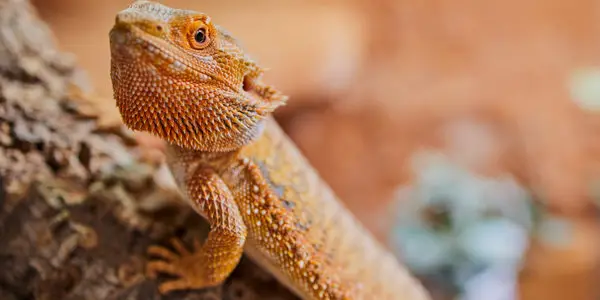
8. Loss of Appetite
Food forms a crucial part of the growth process. It provides all the nutrients, minerals, and energy to fuel growth and development.
Further, food supplies other valuable components for normal growth such as antioxidants that aid in fighting disease-causing organisms.
Thus, a dwindling or lost appetite is likely to cause malnutrition in your beardie. As a result, the lizard’s body struggles to supply the energy and nutrients for standard growth, leading to undersized bearded dragons.
The commonest causes of loss of appetite in beardies include:
- Elevated stress levels
- Insufficient cage space to feed, roam, bask, lay eggs, and sleep
- New artificial habitat (tank and surroundings)
- Inadequate hiding spots inside the tank
- Unsuitable terrarium placement- presence of external elements such as unusual noise, uncontrolled light, and sight of other intimidating creatures
- Mishandling and over-handling
If you’ve supplied your beardie with sufficient and balanced diets but they seem not to have a desire to eat, they most probably have a loss of appetite.
In such cases, look into the other aspects to identify why their desire to feed is failing and then resolve the underlying problem.
If you can’t pin-point the issue at play, it possibly best to consult your reptile pet vet for help.
9. Early Brumation
Bearded dragons regularly undergo brumation in their natural habitats to save up their energy reserves over the tough cold season.
Similarly, some captive beardies go into some form of brumation in their tank by slowing down their usual physical activity, feeding less, and sleeping more.
Although brumation is normal in some caged beardies, it should ring a warning bell if it comes too early in a young bearded dragon.
Remember the early days are crucial for your pet to grow to their full size and develop various organs, systems, and other attributes.
Thus, skimping on food in the early stages can cause serious stunted growth in a captive beardie.
Probably the best way to help a beardie whose growth is affected by early brumation is by consulting a reptile veterinarian.
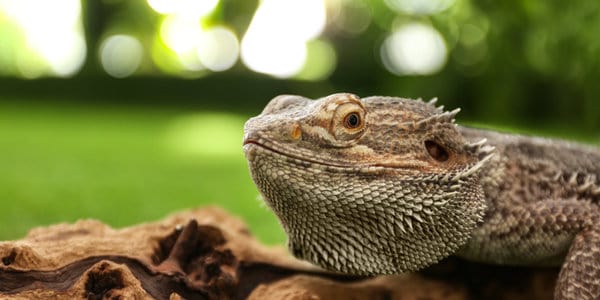
10. Illness
A serious sickness in a young bearded dragon can also impede their normal growth and make them appear smaller than normal.
Infections in bearded dragons can come from various sources such as a dirty habitat, contaminated food, and parasite infestation.
Moreover, a reduced appetite can lead to low food consumption and the consequent undernourishment. Eventually, the malnourishment eats away at the beardie’s health and causes retarded growth.
Fortunately, it’s easy to keep disease away from your beardie to guarantee them a healthy growth trajectory. Here’s how:
- Keep the bearded dragon food and water clean to avoid contamination
- Maintain recommended temperature and humidity levels inside your beardie’s tank
- Observe hygiene throughout the bearded dragon’s enclosure
- Avoid feeding your beardie with wild insects to prevent wild-borne contaminants and diseases
11. The Species of your Bearded Dragon
A number of bearded dragon species are naturally small and won’t grow past a certain size.
Although most bearded dragons that are tamed and housed as pets belong to the Central bearded dragon (Pogona vitticeps) species, several other species are smaller.
The Pygmy bearded dragon (Pogona henrylawsoni), for instance, grows to a maximum length of only12 inches!
Therefore, it’s important to be sure what breed of beardie you’re keeping and their respective sizes at each stage of growth. Only then would you be able to determine whether their growth is normal or erratic.
Why is My Bearded Dragon Staying Small?
Naturally, some breeds of bearded dragons are smaller than others and therefore won’t grow past a particular size regardless of the conditions inside and outside their tank.
However, other species of beardies can grow bigger but stay small due to stunted growth.
In most cases, retarded growth in bearded dragons arises from malnutrition, poorly balanced beardie diet, unsuitable UVB light setup, parasites, early brumation, disease, unfavorable temperatures inside the tank, or insufficient cage space for various activities like feeding, roaming, basking, and sleeping.
Moreover, a bearded dragon can remain uncharacteristically small if they share their tank with another beardie or other competing pet.
These lizards are extremely territorial, so you can expect them to fight for dominance of space and other resources like food and basking spots.
Beyond that, elevated stress levels in a beardie can cause the lizard’s appetite to plummet, and a consequent decline in growth and overall health.
Here’s the good news: Regardless of the reason for your bearded dragon staying small, there’s a remedy. All you need is to identify the underlying reason for the stunted growth and then resolve it.
After that, your beloved beardie will resume their normal growth and bloom to a healthy, full-sized, and happy adult pet.
How Long Does it Take Bearded Dragons to Grow?
If you’ve recently adopted a baby beardie, no doubt you’re excited about their growth and would love to monitor it every step of the way. After all, this is one of the best ways to determine whether their growth and health are on course.
Moreover, monitoring the growth of your beardie enables you to set aside the right proportions of food, water, energy, time, space, and other resources for the pet to thrive at each stage of their life.
Typically, bearded dragons take anywhere between 8 to18 months (approximately one year) to grow to maturity. Within this period, the lizards can reach a mature size of approxiately15 to 24 feet in length.
Although individual beardies and different species of bearded dragons grow at slightly different rates, most of their growth attributes are similar.
For instance, baby beardies grow at a surprisingly high rate during their first few months. You can expect a growth rate of approximately one inch per week over the first five months.
After a year, most beardies are often about 95% mature in size. They continue growing slowly into the second year although the growth is hardly perceptible. After about 18 months, most bearded dragons are fully grown and won’t increase in length anymore.
You must be wondering what happens to beardies’ growth after about a year. Once they’re fully grown, beardies start bulking up on fat, muscle, and putting on weight.
At this point, you’ll notice that the lizards’ appearance transforms from lanky to plump.
Bearded Dragons Growth Monitoring Chart:
| Average Age | Average Size (Length) | Average Body Weight (Grams) |
| 1 Month | 3-4 inches | 4-6 |
| 2 Months | 5-9 inches | 8-40 |
| 3 Months | 8-11 inches | 22-110 |
| 4 Months | 9-12 inches | 41-115 |
| 5 Months | 11-16 inches | 102-115 |
| 6 Months | 11-18 inches | 183-188 |
| 7 Months | 13-18 inches | 230-280 |
| 8 Months | 13-20 inches | 252-327 |
| 9 Months | 14-21 inches | 280-360 |
| 10 Months | 15-22 inches | 280-360 |
| 11 Months | 15-23 inches | 350-465 |
| 12 Months | 15-24 inches | 350-465 |
| 13-18 Months | 15-26 inches | 380-510 |
This chart illustrates the average size (length) and body weight of most bearded dragon breeds at specific age points
Although the weight and size readings are mere averages and estimates, they offer critical insight into the growth progress of beardies at all stages.
What’s more, you can measure the exact length of your beardie and then use the chart to determine their average age.
Just ensure you take the measurements from the tip of their nose to the tip of their tail to get accurate readings.
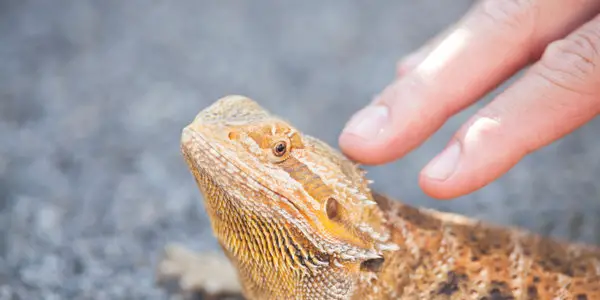
What Foods Help Bearded Dragons Grow?
Like all other animals, bearded dragons require a sufficient supply of nutrient-rich food in their diet to drive off hunger and supply valuable nutrients.
A balanced and adequate beardie diet fosters growth and development, keeps the lizards warm, and bolsters their immunity to combat illnesses.
Here’s a point to note: the right diet for your beardie varies with the pet’s age. Moreover, the frequency of feeding also varies with the age of the beardies.
Baby Bearded Dragons Diet
Baby and young beardies require high protein and calcium levels to support their astronomical growth over the first few months. Thus, they should eat a diet consisting of about 75% insect protein and 20% plant material (veggies and leaves), and 5% fruits.
At this stage, it’s recommended that you feed the beardies with small insects such as crickets and grasshoppers that are rich in fat and protein.
Additionally, supplementing the beardie’s diet with gutted and calcium-dusted insects provides the young lizards with sufficient proteins, fats, calcium, and other vital nutrients for healthy growth.
Beyond a balanced diet, young bearded dragons are voracious eaters that require frequent feeding to satisfy.
It’s recommended to feed them a balanced diet selection 3-5 times daily. Further, allow them to eat as much food as possible within 5 to15-minute intervals.
Adult Bearded Dragons Diet
Unlike juvenile beardies, adult bearded dragons (around 12 months or older) require less proteins as their bodies have most likely grown to their full size. Nevertheless, beardie nutritionists recommend feeding them a diet of 25% protein-rich insects and 75% nutritious plant composites such as veggies, fruits, and salad.
Beyond 12 months, most captive beardies are full-grown adult pets. However, you still need to feed them plenty of calcium-rich foods and provide sufficient UVB light to keep their muscles and bones healthy, bulk up, and strengthen their organs and various structures such as digestive and immune systems.
Beside a balanced diet, remember to feed your adult beardies at least once every two days to keep them satisfied and properly nourished.
To guarantee young and adult bearded dragons a healthy living, ensure their diet is not only adequate but also supplies a rich selection of vital nutrients. These beardie food varieties can help you to balance out the diet:
- Crickets
- Roaches
- Commercial bearded dragon food
- Superworms
- Gutted and calcium-dusted crickets and grasshoppers
- Dark and leafy greens
- Fresh veggies
- Tropical fruits and salad
Although beardies are mighty fond of worms, feed them earthworms, mealworms, and wax worms less frequently as they’re highly addictive. Furthermore, avoid feeding beardies with these dangerous foods:
When Do Bearded Dragons Stop Growing?
Typically, bearded dragons take between 8-12 months to grow to maturity. At this point, the lizards have grown to their maximum size of 15-24 feet depending on the individual beardie, breed, and other aspects including diet, tank conditions, and terrarium placement among others.
However, most beardies are only considered adults after 18 months when they hit full sexual maturity. This is when their growth stops and they start bulking up on muscle, fat, and other body tissues.
It’s vital to keeping tracking your beardie’s growth to determine whether you’re providing all prerequisites for healthy growth and development. You can achieve this by:
- Regularly taking size (length) and weigh measurements, and then cross-referencing them with the bearded dragon growth monitoring table
- Taking frequent photos of your beardie and comparing them with previous shots
- Monitoring their shedding frequency– young, healthy, and growing beardies shed their skin at least once every four weeks whereas healthy adult bearded dragons shed less frequently (often once in a few months).
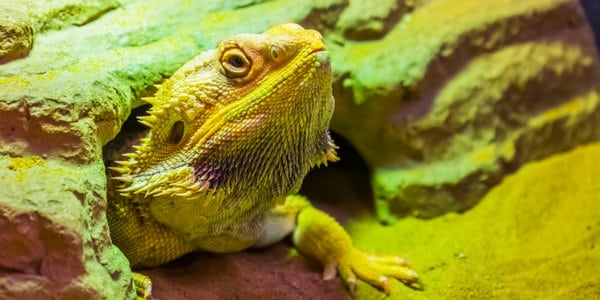
Final Thoughts
So, why is my bearded dragon not growing? Usually, bearded dragons don’t grow properly due to malnourishment or unfavorable living conditions inside their tank such as presence of pests, unsuitable light setup (insufficient UV light), and inadequate space. Nevertheless, some species of bearded dragons are naturally smaller and thus won’t grow as big as others.
Although all baby bearded dragons are roughly only a few feet long, they grow at an exorbitant rate of a few feet per month over the next few months.
At 8-12 months, most beardies are considered adults with a length of 15-26 feet and a weight of 380-510 grams. Nevertheless, the majority hit sexual maturity at around 18 months.
While there’s no fixed standard size for bearded dragons of any age or breed, keeping tabs on your beardie’s size (length and weight) is vital to monitor their growth and health.
Stunted growth before a year elapses often indicates that something is wrong. To resolve the issue, immediately look into the pet’s diet and tank conditions including UVB lighting, temperature, humidity, and hides.
Moreover, a reptile vet visitation can also determine whether beardie parasites or diseases are obstructing normal growth.
Normally, an adequate and balanced diet, suitable tank and surrounding conditions, and proper care are sufficient to guarantee bearded dragons an all-round healthy growth curve.
READ NEXT: How To Make My Bearded Dragon Grow Faster? Full Guide!
